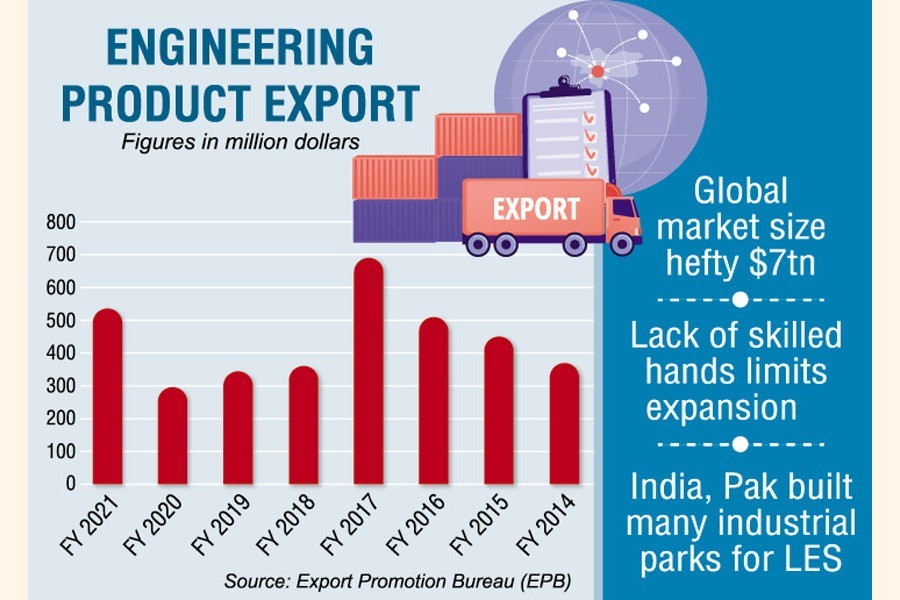Bangladesh's light-engineering sector (LES) lights up trade hopes as it achieved nearly 81-per cent growth in shipments to overseas markets in the last fiscal year (FY), analysts say, as the country strives to enlarge its slim export basket.
They said light-engineering, a hub for nearly 800,000 jobs, after meeting some 30 per cent of local demands, earned about half a billion US dollars in foreign exchange on average per annum.
According to the Export Promotion Bureau (EPB), the Bangladeshi small and medium scale manufacturers exported US$529 million worth of engineering goods in the FY 2020-2021, posting an 80.60 per cent growth year on year.
In the previous FY2020, the export of engineering products fetched $292.92 million, EPB data showed.
Bangladesh has attained a very small pie of the global big export cake as its international market size is of a hefty $7 trillion, the analysts said Wednesday.
Bangladesh mainly exports bicycle, electrical equipment, construction-related equipment and machinery, stone and brick crushers, spare parts for paper and cement mills, bicycle light fittings, cast-iron articles, carbon rods and automobile spares, train-and-rail-support equipment, marine spare parts and the like.
A recent International Finance Corporation IFC study showed Bangladesh's LES has in its employment 600,000 people involved in 50,000 micro-enterprises and 10,000 Small and Medium Enterprises (SMEs).
President of Bangladesh Engineering Industry Owners Association (BEIOA) Abdur Razzak told the FE that the export glory ricocheted in the FY2021 from three years of falling shipments.
"We were hopeful about getting a boost in the coming days as the SMEs and micro-industries are trying hard to improve their enterprises into a modern one and produce quality products for the shipments," he added.
An FE analysis has found the country's export of the engineering products in FY2017 was highest within a decade as Bangladesh earned a record amount of $688.84 million.
But the shipments had faced a steep fall since the subsequent fiscal year with $355.97 million earned in FY2018, $341.3 million in FY2019 and $292.92 million in FY2020.
But it again went on a rebound in FY2021 with its 80.60-per cent growth to $529 million, the EPB data show.
Meanwhile, Prime Minister Sheikh Hasina in January 2020 announced light engineering as the "product of the year" in an attempt to bring special attention onto the sector so that it increases the country's foreign-exchange reserves through the export of various goods.
Afterwards, the industries ministry decided to set up light-engineering industrial parks in Dhaka, Narayanganj, Jashore, Bogura and Narsingdi to reach the growing domestic sector to its full potential.
The micro enterprises and SMEs in the sector are now providing support to the country's industrial, agricultural and construction sectors through manufacturing a wide range of spare parts, castings, moulds and dices, oil-and gas-pipeline fittings and light machinery, BEIOA President Mr Razzaque said.
Various electrical products such as sockets, cables and electrical fans are manufactured in the light-engineering sector with domestic suppliers accounting for 48 to 52 per cent of the country's demand, which previously used to be met with imports.
The Business Promotion Council operating under the commerce ministry estimates that local light-engineering industries produce 3,815 types of machinery, spares and accessories.
The BEIOA President said they were struggling with fund-and skilled-manpower shortages to upgrade the country's light-engineering sector, resulting in a lower export growth than a huge potential.
"We want to modernize our enterprises. But we have lack of funds and manpower. Besides, we need the industrial park for flourishing as an international- standard industry in order to compete on the overseas market," he added.
Centre for Policy Dialogue (CPD) Research Director Dr Khandker Golam Moazzem also sees a huge untapped potential in Bangladesh for engineering- product shipments.
"But its main obstacles are the absence of international-standard certification, skilled manpower, infrastructure and branding. When these problems will be overcome, the country's engineering products will emerge as another forex-earner, reducing dependency on RMG," he told the FE.
Bangladesh should invite some international-standard enterprises like Korean Hyundai for investment aimed at transferring technical know-how, developing skilled manpower and building the country's image, the economist suggests.
When asked, Director-General of Bangladesh Industrial Technical Assistance Centre (BITAC) Anwar Hossain Chowdhury told the FE that they had a lack of high-skilled and international-standard trainers at their place.
"We are supplying lot of skilled manpower for the local light-engineering sectors. But we could not develop manpower up to the international standards due to the trainer shortage," he added.
They have recently set up Tools and Technology Institute at BITAC which is helping the local SMEs to standardize their products. Gradually they plan to turn the institute into an international-standard body for certification and developing high-skilled manpower.
Analysts said neighbouring India and Pakistan have already set up many industrial parks for light-engineering sector and earning billions of dollars every year.
Since global market size of the light-engineering products is about $7 trillion and European and American markets had a duty-free access for Bangladesh, there are huge potentials for boosting its shipments through producing international-standard products, they observed.


